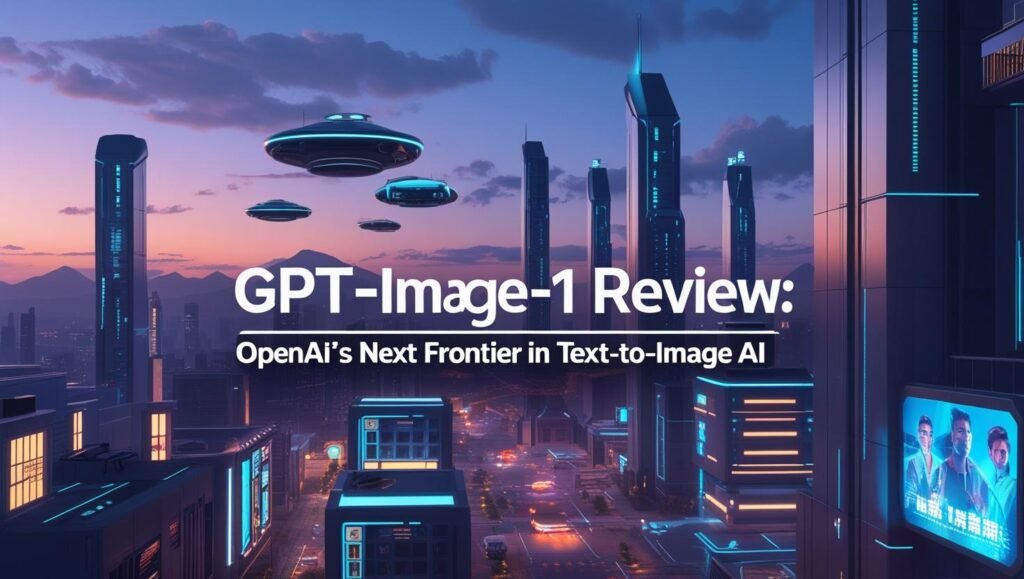GPT‑Image‑1 Review: OpenAI’s Next Frontier in Text-to-Image AI

What Is GPT‑Image‑1?
GPT‑Image‑1, released by OpenAI in April 2025, marks a major leap in image generation. It integrates seamlessly into the GPT‑4o multimodal family, replacing DALL·E 3 and offering higher resolution visuals, sharper text fidelity, and conversational editing directly through the API.
When this launched, The Verge described it as a “step change above previous models,” highlighting a new autoregressive method that boosts accuracy in text placement and object binding (The Verge).
Core Features That Matter
Conversational Image Editing
Request a scene, critique it, ask for tweaks (“remove the tree,” “brighten the sky”), and it adapts in real time—thanks to GPT‑4o-powered inpainting tools.
High-Resolution Output
Generates up to 4096×4096 resolution images with realistic textures, lighting, and photoreal clarity.
Prompt Fidelity
Handles nuanced instructions better than DALL·E 3, making it ideal for complex creative tasks.
Safety & Metadata
Includes C2PA metadata for traceability and follows GPT‑4o’s content policies, offering guardrails while generating images.
Real-World Use Cases
Creative & Marketing Workflows
Whether you’re crafting social media banners or website visuals, GPT‑Image‑1 supports rapid iteration and text clarity, a game-changer compared to more static models.
UX/UI Prototyping
It works well in platforms like Figma and Adobe Firefly, enabling designers to tweak elements conversationally—without leaving the design environment (TechCrunch). If you’re exploring co-pilot image creations, this model is a strong addition—for more on that, check out our deep dive on Co‑pilot image generators explained and why digital artists are paying attention.
Publishing & Infographics
Because of its high-quality output and editable text overlays, it’s a reliable tool for infographics, e-learning visuals, and educational diagrams. Be sure to reference how DALL·E is transforming digital art and design for comparison.
Tech Behind the Scenes
GPT‑Image‑1 is built on GPT‑4o’s multimodal architecture, combining autoregressive text/image generation and diffusion-style decoding. It’s accessible via:
- OpenAI Images API
- ComfyUI nodes for local editing workflows
- Integrations with Adobe, Canva, Figma, and more
Great prompt engineering—outlined in our guide to Mastering machine learning: a beginner‑friendly guide to key algorithms—helps get optimal results quickly.
Expert Opinions & Performance
- The Verge called it a “conversational image creation” milestone with accurate editing in chat (The Verge).
- TechCrunch reported that GPT‑Image‑1 caused an explosion of sign-ups after its launch and can process multi-image requests efficiently with built-in safety filters (TechCrunch).
Pricing & Access
GPT‑Image‑1 is accessible through OpenAI’s Images API:
- $5 per 1M text tokens
- $10 per 1M image tokens
- $0.19 per high-quality image generated
A free tier is rolling out, though subject to usage limits—OpenAI delayed free availability briefly due to high demand (The Verge).
Potential Challenges
- Editing limitations: No vector layers or infinite canvases yet
- Budget concerns: Costs can escalate fast in high-volume or HD use
- Bias & moderation: Requires careful prompt design and review
- Tooling still evolving: Documentation and integration tools are improving
Responsible Use Tips
- Always moderate due to potential bias
- Include text in prompts for more consistent results
- Use C2PA metadata to mark AI-generated work
- Monitor Access Policy changes—OpenAI is adjusting moderation levels over time
Final Verdict
GPT‑Image‑1 is a milestone: conversational editing, text clarity, and integration with design tools make it the most practical image model yet. Though pricier than diffusion-only models and lacking fine-grain editing, its interactivity and fidelity make it perfect for developers and creative teams.
Interested in exploring more ways to harness multimodal AI? Our guide to DALL·E’s transformation of digital design is an ideal next step.
